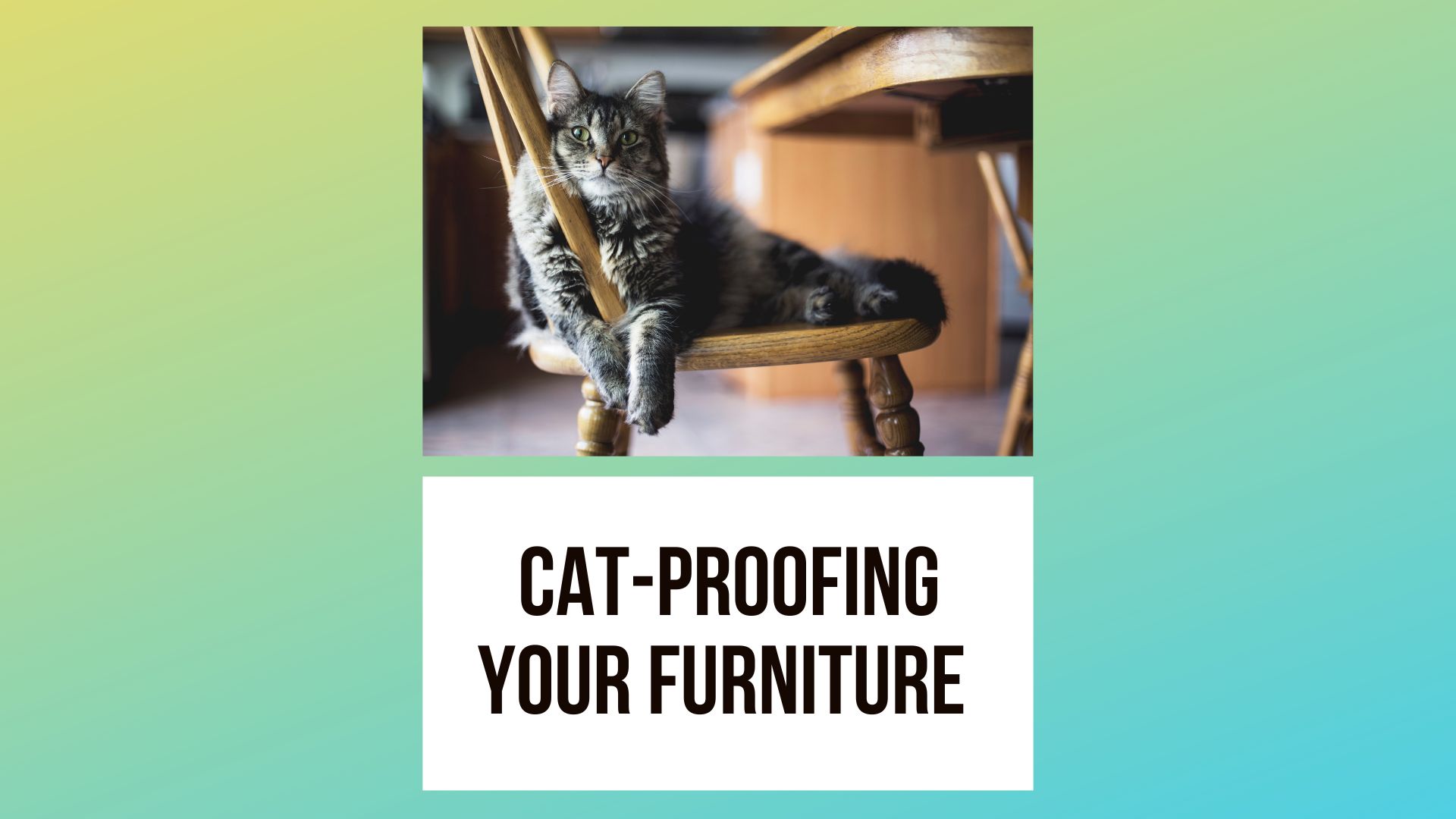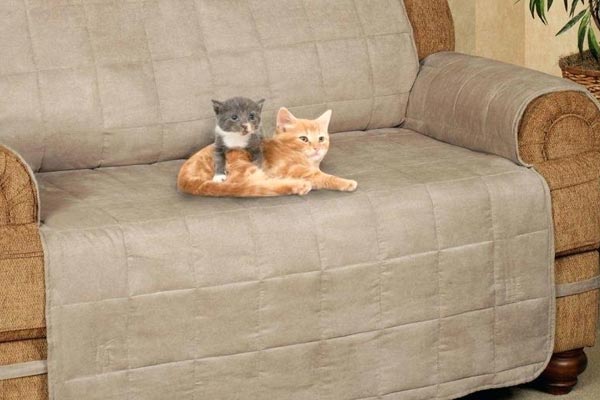
How to cat proof furniture? We all love cats. They’re animals that have their own personalities, and they express that in a number of different ways.
Once you’ve adopted a cat into your home, it can be difficult to adjust the environment to accommodate both your and your cat’s needs.
Cats typically establish their rules of territory between the first two weeks and two months in their new household.
During this period of time, a cat may take its toll on your furniture by scratching or spraying. Many pet owner has faced quite a challenge in dealing with pet hair and odor.
Thankfully, there are methods you can use whether you are interested in purchasing new furniture, or looking to cat-proof your current furniture.
How can I prevent my cat from scratching the furniture?
Use Scratching posts or decoys to attract their attention
According to Dr. Jeffrey Levy, cats find it necessary to scratch for a number of reasons: It helps them to stretch, release tension, trim their nails, and mark territory.
This is why it’s essential for you to get a scratching post so that cats can release these urges, without damaging your couch.
Placing a scratching post near your couch is a good idea, but having another one by the cat bed and other prominent areas of your home is important.
Since scratching is a way for cats to mark territory, the posts will need to be in important places throughout the house.
If your cat doesn’t take to the posts right away, you can try applying different textures and shapes to get them interested.
Treat your furniture with natural scents and sprays
Once you have secured a post or area where your cat can do their necessary scratching, the next step is to treat your furniture to repel cats.
There are a number of natural elements that cats are not a fan of, so you don’t have to worry about treating your house with harsh chemicals.
Thanks to instructional YouTube videos like this one from Awesome A, the average cat owner can create solutions out of vinegar, rosemary, and citrus to keep cats away from the furniture.
Cover the furniture with textures that cats dislike
Remedies like vinegar and spraying citrus can be effective, but maybe you don’t want to be burdened with those overwhelming smells in your home.
Just as cats like certain textures (carpet, fabric, etc) more than others, there are some feelings and textures that they just can’t stand.
WikiHow has a great listing of products you can try, such as double-sided tape, vinyl floor runners, or plastic sofa covers.
Cats have very sensitive paws, so anything with a texture that is too sticky or too smooth will be great at preventing them from scratching.

NEVER declaw your cats to stop them from scratching!
Although it’s a good idea to keep your cat’s nails groomed properly, it is important to keep in mind that a cat’s claw grows directly from its phalanges.
Cats have a number of sensitive nerve endings and blood vessels in their claws that can be severely damaged in the de-clawing process.
According to Change.org, As of May 2018, the de-clawing procedure was completely banned in British Columbia and also in a number of U.S. cities such as Beverly Hills, Santa Monica, Los Angeles, and San Fransisco.
The process of de-clawing not only seems to have little to no benefits, but it can also create a number of physical issues, like wrist, knee, and other joint pains, and it can cause a number of behavioral problems (no longer using litterboxes, constant spraying from stress, etc.)
As frustrating as furniture scratching can be, it is easily solved through other means and de-clawing should never be a consideration for such a simple problem.
According to Paws.org, Here is a listing of problems that most cats experience after being de-clawed.
Most veterinarians only recommend de-clawing as a last resort for serious issues like euthanization.
While scratching can be frustrating for the owner, please remember that cats scratch for very specific reasons and declawing goes against their natural behaviors and instincts.
What should I do if my cat is spraying the furniture?
Identify the cat’s reason for spraying
If you have a fairly young cat, spraying can be a common problem. While spraying is typically a behavior present in male cats, some females will also spray their home as a way to mark their territory.
Usually, if a cat is spraying, it is doing so because something triggered a territorial or anxious response.
The best way to prevent this behavior is by identifying what triggered this anxiety in the first place.
Here are some examples of things that can cause cats to do this:
- The presence of stray cats around the house
- A new pet being inside of the house
- The cat needs to be neutered
- A more serious medical issue
Spaying or neutering your cat will typically prevent the spraying habit, and the team at PetCare Rx Inc recommends that you neuter/spay your cats between the ages of five and six months.
Desexing your cat any earlier than this can cause complications for your cat, such as a urinary tract infection.
While it is possible to desex your cat at an older age, a cat becomes more set in its habits the more mature it gets, so doing this as early as possible will help prevent the issue.
Even if a cat is fixed, you may observe them spraying urine in or outside of the home.
This normally occurs when the cat becomes stressed by something, usually another animal being present in their environment.
Ensuring that all of your animals are introduced properly and given adequate space away from each other is key to making them less stressed about the change.
According to SFGate, There are a number of plants that cats are repelled by, so sometimes planting Rue, Lavender, or Citronella can deter stray cats from roaming around your home, which in turn, makes your cats more relaxed.
Helping your cat relax in the face of unknown stressors is key to protecting your furniture. Cats can de-stress using any of the following items:
Synthetic Pheromones
Implementing things like synthetic pheromones can work to reduce stress levels in single and multi-cat homes. They are also a great option if you’re looking to limit scratching!
Self Groomers
You may notice on occasion that your cat rubs its face against things. Doing this often releases pheromones that help cats relax.
Try applying a self-grooming device for your cat, as these tend to make cats feel more happy and relaxed. These groomers can be attached to the wall, or stand-alone.
Herbs
A number of cat owners have had great success with relaxing their cat by using herbs such as Chamomile or Valerian. You can find a complete listing of herbs that your cat can enjoy, According to PetMD.
If you try these methods and you still find that your cat is spraying, there may be a more serious issue at play.
If you notice that your cat is urinating often in the wrong places, this could be a sign of a urinary tract infection.
UTIs can be a very common problem for cats who were spayed or neutered too early and have an effect on male cats more often.
Treat the areas that have been sprayed
To prevent your cat from spraying the furniture, it’s important to identify your cat’s favorite spots to spray.
The areas your cat sprays most often must be completely deodorized and cleaned so that the cat can no longer find them.
Typically, your cat will spray around its favorite spots (the litter box, their bed, lounging spots, etc.)
According to WikiHow, you should avoid using cleaners with any type of ammonia, as they only amplify the urine scent left by cats.
Utilizing an enzymatic neutralizer deters most cats from spraying that spot, so treating your furniture with this, along with some citrus-based scents, should keep your cat away from the area.
If you’re not sure how thorough your cleaning of the area was, you can try using a blacklight to catch stains that are otherwise invisible during the day.
While methods like this are great for preserving and cat-proofing your current furniture, you may be interested in investing in new items that can stand up against felines.
The great news is that you have a lot of options for cat proof furnishings.
What types of furniture are good for a home with a cat?
Pay attention to the fabrics and materials that your furniture is made of
As mentioned before, cats are very sensitive to the way that textures feel. Cats tend to avoid knobby or bumpy textures, and of course the more thick and durable the material, the better.
Synthetic fibers, like suede and other microfibers, seem to be the best options, but leather can be just as effective. Velvet is another recommended material that seems to work well in cat homes.
Finding a texture that cats won’t scratch or spray on is important, but when dealing with any pet, it’s important to find furniture that is resistant to cat hair and odor as well.
Some materials like wool or felt will hold odors in, while some can be more difficult in terms of treating stains, like suede.
This YouTube video from interior designer Cathy Hobbs professes that leather is the best material for furniture due to its durability and the fact that it doesn’t hold odors like microfiber.
Invest in furniture that comes with slipcovers
Slipcovers are a great alternative if you still want your furniture to be cat-friendly and durable against damage.
Vinyl, as aforementioned, is great for preventing scratching, so it makes great material for slipcovers.
Wool or felted slipcovers work well for many pet owners, but they tend to attract large amounts of fur.
Most companies offer slipcovers specifically designed to be pet-proof, so you can usually find a decent slipcover sold with the furniture, or separately.
Research newer furniture that is designed to be cat proof.
IKEA recently released their sofa called KÄT, advertised as “The World’s First Cat-Proof Sofa.” The design of this couch is unique because of its cardboard base.
The base of the sofa is comprised of biodegradable cardboard, so cats can enjoy tearing it into it without damaging the rest of the fixture.
Since this sofa is one of the first of its kind, it is not advisable to invest in it immediately. Since the sofa is relatively new, its design will go through a trial-and-error process, so paying attention to customer reviews is essential before buying.
There are a number of other brands that are built to be animal resistants, such as Mambe.
Research Before You Buy Furniture
As always, do your research on new products before investing, as they can be costly and expensive.
Owning a cat is a long-term commitment. There are a number of things you have to consider when adopting a new member into your family, and having fixtures that stand up to the odd behaviors of your animal is important.
The right furniture for your home may vary depending on your breed of cat and its personality.
Making sure to research the types of materials used is the best way to find a fixture that stands up to pet odor, hair, and scratching.
Whether you’re shopping for new furnishings, or looking to protect your old furniture from pet damage, you have a variety of options.

Hi, This is Alexa, and I love cats. This Website is a Complete Journal about how to travel with a cat and other information about Cat Health, Cat Training, Cat Behavior, Cat Foods and more. I hope you find it useful.
